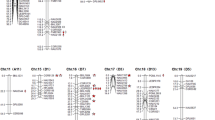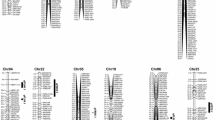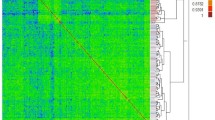Abstract
Cotton fiber properties are very important to the yarn quality. Modern high-speed textile operations around the world require long, strong and fine cotton fibers. The objective of this research was to identify stable fiber quantitative trait loci (QTLs) that could be used in cotton breeding through marker-assisted selection (MAS). Two cotton lines, MD90ne and MD52ne, are near-isogenic with significant differences in fiber properties, especially strength. Fiber samples from 734 progeny plants of two F2 populations (A and B) derived from crosses between MD90ne and MD52ne were collected at Stoneville, MS, USA in 2012. Fiber quality attributes were measured using a High Volume Instrument 1000. A simple sequence repeat (SSR) genetic linkage map with 165 loci covering 632.53 cM was constructed using population A, consisting of 356 F2 individuals and used for identifying QTLs related to fiber bundle strength (FBS), short fiber index (SFI) and upper-half mean fiber length (UHML). One QTL for FBS originating from the stronger fiber parent MD52ne was identified on chromosome (Chr.) 3. Three QTLs each for SFI and UHML were identified on Chrs. 3, 4 and 14 and Chrs. 3, 11 and 24, respectively. Population B, consisting of 378 F2 progeny, was used to confirm these QTLs by analyzing 57 SSR markers mapped on Chrs. 3, 14 and 24. Three QTLs—qFBS-c3, qSFI-c14 and qUHML-c24—were confirmed and appeared stable. These three QTLs could potentially be used in breeding to improve cotton fiber quality through a MAS strategy.



Similar content being viewed by others
References
Blenda A, Fang DD, Rami JF, Garsmeur O, Luo F, Lacape JM (2012) A high density consensus genetic map of tetraploid cotton that integrates multiple component maps through molecular marker redundancy check. PLoS One 7:e45739
Chee PW, Campbell BT (2009) Bridging classical and molecular genetics of cotton fiber quality and development. In: Paterson AD (ed) Genetics and genomics of cotton. Springer, New York, pp 283–311
Chen H, Qian N, Guo W, Song Q, Li B, Deng F, Dong C, Zhang T (2009) Using three overlapped RILs to dissect genetically clustered QTL for fiber strength on Chro. D8 in Upland cotton. Theor Appl Genet 119:605–612
Chen X, Guo W, Liu B, Zhang Y, Song X, Cheng Y, Zhang L, Zhang T (2012) Molecular mechanisms of fiber differential development between G. barbadense and G. hirsutum revealed by genetical genomics. PLoS One 7:e30056
Fang DD, Xiao J, Canci PC, Cantrell RG (2010) A new SNP haplotype associated with blue disease resistance gene in cotton (Gossypium hirsutum L.). Theor Appl Genet 120:943–953
Fang DD, Hinze LL, Percy RG, Li P, Deng D, Thyssen G (2013) A microsatellite-based genome-wide analysis of genetic diversity and linkage disequilibrium in Upland cotton (Gossypium hirsutum L.) cultivars from major cotton-growing countries. Euphytica 191:391–401
Felker GS (2001) Fiber quality and new spinning technologies. In: Dugger P, Richter DC (eds) Beltwide cotton conferences. National Cotton Council of America, Anaheim, pp 5–7
He D, Lin Z, Zhang X, Nie Y, Guo X, Zhang Y, Li W (2007) QTL mapping for economic traits based on a dense genetic map of cotton with PCR-based markers using the interspecific cross of Gossypium hirsutum × Gossypium barbadense. Euphytica 153:181–197
Hinchliffe DJ, Meredith WR, Yeater KM, Kim HJ, Woodward AW, Chen ZJ, Triplett BA (2010) Near-isogenic cotton germplasm lines that differ in fiber-bundle strength have temporal differences in fiber gene expression patterns as revealed by comparative high-throughput profiling. Theor Appl Genet 120:1347–1366
Hinchliffe DJ, Meredith WR, Delhom CD, Thibodeaux DP, Fang DD (2011) Elevated growing degree days influence transition stage timing during cotton (Gossypium hirsutum L.) fiber development and result in increased fiber strength. Crop Sci 51:1683–1692
Hinze LL, Dever JK, Percy RG (2012) Molecular variation among and within improved cultivars in the U.S. cotton germplasm collection. Crop Sci 52:222–230
Kohel R, Yu J, Park Y-H, Lazo G (2001) Molecular mapping and characterization of traits controlling fiber quality in cotton. Euphytica 121:163–172
Kosambi DD (1944) The estimation of map distances from recombination values. Ann Eugen 12:172–175
Lacape JM, Nguyen TB, Thibivilliers S, Bojinov B, Courtois B, Cantrell RG, Burr B, Hau B (2003) A combined RFLP-SSR-AFLP map of tetraploid cotton based on a Gossypium hirsutum x Gossypium barbadense backcross population. Genome 46:612–626
Lacape JM, Nguyen TB, Courtois B, Belot JL, Giband M, Gourlot JP, Gawryziak G, Roques S, Hau B (2005) QTL analysis of cotton fiber quality using multiple G. hirsutum × G. barbadense backcross generations. Crop Sci 45:123–140
Lacape JM, Llewellyn D, Jacobs J, Arioli T, Becker D, Calhoun S, Al-Ghazi Y, Liu S, Palai O, Georges S, Giband M, de Assuncao H, Barroso PA, Claverie M, Gawryziak G, Jean J, Vialle M, Viot C (2010) Meta-analysis of cotton fiber quality QTLs across diverse environments in a Gossypium hirsutum × G. barbadense RIL population. BMC Plant Biol 10:132
Lin Z, He D, Zhang X, Nie Y, Guo X, Feng C, Stewart JM (2005) Linkage map construction and mapping QTL for cotton fiber quality using SRAP, SSR and RAPD. Plant Breed 124:180–187
McCouch SR, Cho YG, Yano PE, Blinstrub M, Morishima H, Kinoshita T (1997) Report on QTL nomenclature. Rice Genet Newsl 14:11–13
Mei M, Syed NH, Gao W, Thaxton PM, Smith CW, Stelly DM, Chen ZJ (2004) Genetic mapping and QTL analysis of fiber-related traits in cotton (Gossypium). Theor Appl Genet 108:280–291
Meredith MR (1984) Quantitative genetics. In: Koh JW, Lewis CF (eds) Cotton. Crop Science Society of America, Madison, pp 132–147
Meredith WR (2005a) Minimum number of genes controlling cotton fiber strength in a backcross population. Crop Sci 45:1114–1119
Meredith WR (2005b) Registration of MD 52ne high fiber quality cotton germplasm and recurrent parent MD 90ne. Crop Sci 45:806–807
Paterson AH, Wendel JF, Gundlach H, Guo H, Jenkins J et al (2012) Repeated polyploidization of Gossypium genomes and the evolution of spinnable cotton fibres. Nature 492:423–427
Percival AE, Kohel RJ (1990) Distribution, collection, and evaluation of Gossypium. Adv Agron 44:225–256
Qin H, Guo W, Zhang YM, Zhang T (2008) QTL mapping of yield and fiber traits based on a four-way cross population in Gossypium hirsutum L. Theor Appl Genet 117:883–894
Rong J, Feltus FA, Waghmare VN, Pierce GJ, Chee PW, Draye X, Saranga Y, Wright RJ, Wilkins TA, May OL, Smith CW, Gannaway JR, Wendel JF, Paterson AH (2007) Meta-analysis of polyploid cotton QTL shows unequal contributions of subgenomes to a complex network of genes and gene clusters implicated in lint fiber development. Genetics 176:2577–2588
Rungis D, Llewellyn D, Dennis ES, Lyon BR (2005) Simple sequence repeat (SSR) markers reveal low levels of polymorphism between cotton (Gossypium hirsutum L.) cultivars. Aust J Agric Res 56:301–307
Said JI, Lin Z, Zhang X, Song M, Zhang J (2013) A comprehensive meta QTL analysis for fiber quality, yield, yield related and morphological traits, drought tolerance, and disease resistance in tetraploid cotton. BMC Genom 14:776
Shen X, Guo W, Zhu X, Yuan Y, Yu JZ, Kohel RJ, Zhang T (2005) Molecular mapping of QTLs for fiber qualities in three diverse lines in Upland cotton using SSR markers. Mol Breed 15:169–181
Shen X, Guo W, Lu Q, Zhu X, Yuan Y, Zhang T (2007) Genetic mapping of quantitative trait loci for fiber quality and yield trait by RIL approach in Upland cotton. Euphytica 155:371–380
Shen X, Cao Z, Singh R, Lubbers EL, Xu P, Smith CW, Paterson AH, Chee PW (2011) Efficacy of qFL-chr1, a quantitative trait locus for fiber length in cotton (Gossypium spp.). Crop Sci 51:2005–2010
Ulloa M, Meredith WR (2000) Genetic linkage map and QTL analysis of agronomic and fiber quality traits in an intraspecific population. J Cotton Sci 4:161–170
Ulloa M, Saha S, Jenkins JN, Meredith WR Jr, McCarty JC Jr, Stelly DM (2005) Chromosomal assignment of RFLP linkage groups harboring important QTLs on an intraspecific cotton (Gossypium hirsutum L.) Joinmap. J Hered 96:132–144
Van Ooijen JW (2006) JoinMap 4.0: software for the calculation of genetic linkage maps in experimental populations. Kyazma B.V., Wageningen
Van Ooijen JW (2009) MapQTL 6, software for the mapping of quantitative trait loci in experimental populations of diploid species. Kyazma BV, Wageningen
Voorrips RE (2002) MapChart: software for the graphical presentation of linkage maps and QTLs. J Hered 93:77–78
Wang B, Guo W, Zhu X, Wu Y, Huang N, Zhang T (2006) QTL mapping of fiber quality in an elite hybrid derived-RIL population of Upland cotton. Euphytica 152:367–378
Yu Y, Yuan DJ, Liang SG, Li XM, Wang XQ, Lin ZX, Zhang XL (2011) Genome structure of cotton revealed by a genome-wide SSR genetic map constructed from a BC1 population between Gossypium hirsutum and G. barbadense. BMC Genom 12:15
Yu JZ, Kohel RJ, Fang DD, Cho J, Van Deynze A, Ulloa M, Hoffman SM, Pepper AE, Stelly DM, Jenkins JN, Saha S, Kumpatla SP, Shah MR, Hugie WV, Percy RG (2012) A high-density simple sequence repeat and single nucleotide polymorphism genetic map of the tetraploid cotton genome. G3 (Bethesda) 2:43–58
Yu J, Zhang K, Li S, Yu S, Zhai H, Wu M, Li X, Fan S, Song M, Yang D, Li Y, Zhang J (2013) Mapping quantitative trait loci for lint yield and fiber quality across environments in a Gossypium hirsutum × Gossypium barbadense backcross inbred line population. Theor Appl Genet 126:275–287
Zhang K, Zhang J, Ma J, Tang S, Liu D, Teng Z, Liu D, Zhang Z (2012) Genetic mapping and quantitative trait locus analysis of fiber quality traits using a three-parent composite population in upland cotton (Gossypium hirsutum L.). Mol Breed 29:335–348
Zhang T, Qian N, Zhu X, Chen H, Wang S, Mei H, Zhang Y (2013) Variations and transmission of QTL alleles for yield and fiber qualities in upland cotton cultivars developed in China. PLoS One 8:e57220
Zhao L, Yuanda L, Cai C, Tong X, Chen X, Zhang W, Du H, Guo X, Guo W (2012) Toward allotetraploid cotton genome assembly: integration of a high-density molecular genetic linkage map with DNA sequence information. BMC Genom 13:539
Acknowledgments
This project was supported by USDA-ARS CRIS project 6435-21000-017-00D and Cotton Incorporated project 10-747. We greatly thank Dr. William Meredith, who developed the cotton lines MD90ne and MD52ne and made them available for us to use in the present research. Our appreciation also goes to Mrs. Sheron Simpson and Dr. Brian Scheffler at Genomic and Bioinformatic Research Unit at Stoneville, MS for their excellent support in SSR marker analysis. Mention of trade names or commercial products in this article is solely for the purpose of providing specific information and does not imply recommendation or endorsement by the U. S. Department of Agriculture, which is an equal opportunity provider and employer.
Author information
Authors and Affiliations
Corresponding author
Electronic supplementary material
Below is the link to the electronic supplementary material.
Rights and permissions
About this article
Cite this article
Islam, M.S., Zeng, L., Delhom, C.D. et al. Identification of cotton fiber quality quantitative trait loci using intraspecific crosses derived from two near-isogenic lines differing in fiber bundle strength. Mol Breeding 34, 373–384 (2014). https://doi.org/10.1007/s11032-014-0040-4
Received:
Accepted:
Published:
Issue Date:
DOI: https://doi.org/10.1007/s11032-014-0040-4




